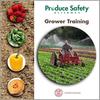Welcome to the University of Vermont Produce Safety Portal
This is a customizable web-portal for produce growers and other produce industry members to access and organize their produce safety world.
From here, users:
- search several different types of produce safety resource, including photos, case studies, and model procedures;
- create accounts, and customize personal “one-stop” dashboards;
- contribute content, ask questions, and stay in touch.
For details about the Portal, please visit the about page.
Questions about searching, creating an account, or submitting your resource? Email the Produce Safety team at hans.estrin@uvm.edu or call 802-257-7967, or give us feedback here.
Start Your Search
There are currently 60 resources published in the portal.
Recent Updates
On-farm Food Safety: Cleaning and Sanitizing Guide

Cleaning and sanitizing are part of an overall food safety plan to provide the safest and best quality fresh fruits, vegetables, greens, and herbs to customers. Checklists, standard procedures, and schedules are typically the best ways to communicate information to employees and document that proper cleaning and sanitizing practices are followed. This fact sheet includes suggested...
Produce Safety Alliance Grower Training Manual

This is the Produce Safety Alliance Grower Training Manual, which is available for public use. The date after the tab name indicates the upload date. As revisions are made the dates will be updated to reflect a revised upload.




